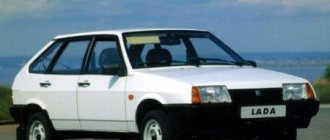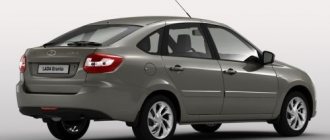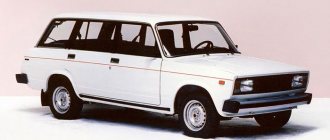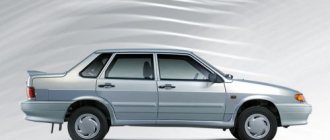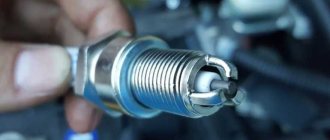The official website of the Lada company indicates that in 2015, XRAY production has already produced 1 generation and 6 modifications of cars, with engine packages that support the EURO V environmental standard with volume: 1596, 1598, 1774 cm3 and power: 106, 110, 113, 122 liters. pp., using as fuel: gasoline, grades AI-95, AI-92, with gearbox: variator, manual, robot. And the fuel consumption of the Lada XRAY in the mixed, urban (in the city) and suburban (on the highway) cycle ranges from 5.6 to 9.7 liters per 100 km, which, with a tank volume of 50 liters, allows you to travel a distance of 520 km. up to 890 km..
Fuel consumption per 100 km for Lada XRAY (since 2015), Hatchback, 1st generation
| Modification | Fuel consumption, l/100 km | Power reserve (km.) | ||
| highway | city | MIX | ||
| 1596 cm³, 106 hp, tank (50 l.) - AI-95, manual transmission, front-wheel drive | 5.9 | 9.3 | 7 | 540 — 850 |
| 1598 cm³, 110 hp, tank (50 l.) - AI-95, manual transmission, front-wheel drive | 5.6 | 8.9 | 6.8 | 560 — 890 |
| 1774 cm³, 122 hp, tank (50 l.) - AI-95, manual transmission, front-wheel drive | 5.8 | 8.6 | 6.8 | 580 — 860 |
| 1774 cm³, 122 hp, tank (50 l.) - AI-95, manual transmission, front-wheel drive | 5.8 | 9.3 | 7.4 | 540 — 860 |
| 1774 cm³, 122 hp, tank (50 l.) - AI-95, manual transmission, front-wheel drive | 6.3 | 9.7 | 7.5 | 520 — 790 |
| 1598 cm³, 113 hp, tank (50 l.) - AI-92, CVT, front-wheel drive | — | — | 7.3 | up to 685 |
What gasoline is better to pour into Lada Vesta and Lada X-ray.
From the legends about the best gasoline for a car, it has long been possible to publish a collection of essays in twenty-seven volumes. Lada Vesta and X-ray are not much different from other cars, so the question “what to pour?” Usually it’s not worth it, however, in the wake of the next crisis, you once again think about what fuel to choose. Fill in the seemingly cheap AI-92 or the recommended AI-95, or you might splurge and fill the car with 98-octane gasoline; perhaps in the future it will pay off in terms of repairs? Personally, I decided on the choice of fuel a long time ago and I want to share with you the arguments in favor of my choice.
Three engines are currently installed on Lada Vesta and Lada X-ray, these are VAZ 21129 (1.6 l.), 21179 (1.8 l.) and the Renault H4Mk. All three engines are very similar, the compression ratio (this is what is important for selecting fuel) is approximately the same 10.5-10.3-10.7 (in the same order), but the fuel requirements are slightly different. From personal experience I can say that the H4M is more capricious in terms of fuel quality; its check light comes on more often and sensors fail. In recent years, the average quality of fuel has improved slightly, but there is still a chance to refuel with a gas station, and in a crisis these chances grow exponentially. I recently filled up at a branded gas station and started misfiring.
Based on the engine compression ratio, you can choose gasoline that is almost ideal for our car.
It is worth remembering that the compression ratio for our engines is fixed, and the octane number of the fuel is often far-fetched, so it turns out that with a borderline compression ratio it is better to take fuel with a higher octane number. As can be seen from the table, if you can still pour 92 gasoline into Ladovsky engines, then only 95 gasoline can be poured into the H4M.
Let me remind you that the use of low-octane fuel is fraught with detonation, which, if it does not lead to engine failure, will significantly reduce its service life.
Personally, I refused to use 92 gasoline while still the owner of a Priora. This was prompted by a change of gas station; after several experiments with different types and brands of fuel, I settled on the most expensive of all the types of gasoline I tried. Surprisingly, by switching to it I began to save money)) - consumption dropped, the car became faster. It seems that the calorific value of all brands is the same, but the effect is obvious, so the question “what to pour?” It didn't stop when I changed the car. There is a completely logical explanation for this, a higher octane number allows the engine to burn gasoline completely, there is no early ignition, gasoline burns a little longer and in the optimal mode for pushing the piston.
Why shouldn’t you put 98-octane gasoline in your Lada Vesta and X-ray?
Firstly, it is simply not economically profitable, it is more expensive, and there will be no difference in dynamics and consumption compared to the 95th.
Secondly, 98 gasoline burns even longer than 95 gasoline, and under certain conditions (for example, on a cold engine and at low speeds, when there is not enough air in the fuel mixture), an increased load on the exhaust valves may occur, and the fuel will not have time to burn out and the flame will enter the outlet. Of course, it’s impossible to say that they will burn out like the classic ones, but it’s not worth the risk.
Source
Lada XRAY fuel consumption calculator: calculate mileage consumption
Using the calculator, you can calculate the fuel consumption for your trip.
The calculator accepts data from the form for the distance of the expected trip in kilometers and helps to calculate the possible fuel consumption in liters. Please note that the data for calculation are taken as averaged for the model; only the maximum and minimum consumption values are taken into account, which may differ depending on the modification of the car. Therefore, the calculation is averaged. liters
km
Calculate
With real fuel consumption in liters, the travel range (depending on the configuration and modification of the car) will be:
- with a consumption of 5.6 liters per 100 km, you can travel a distance of kilometers
- with a consumption of 9.7 liters per 100 km, you can travel a distance of kilometers
To travel a distance of kilometers, you will need (depending on the configuration and modification of the car):
- with a consumption of 5.6 liters per 100 km, liters of fuel are required
- with a consumption of 9.7 liters per 100 km, liters of fuel are required
Reasons for increased gasoline consumption
Having grouped the opinions of users and ranked the reasons for the increased consumption of combustible crossovers, they can be placed in descending order as follows:
- Due to the increase in engine warm-up time, heater operation and seat heating, consumption increases in winter.
- Due to frequent acceleration and braking.
- Due to the use of low-quality or low-octane fuel.
- When using electrical equipment.
- Due to malfunctions and incorrect adjustments of engine systems.
- For various other reasons such as the condition of the air cleaner, tire wear and type, as well as road and even weather conditions.
Lada X-ray fuel consumption table by mileage
The table contains the distances most often of interest and the corresponding fuel consumption indicators by kilometer for the Lada XRAY. The data in the table is averaged and does not take into account the modification and equipment of a particular car, but uses the average data for the model.
| Distance (km.) | Fuel consumption, l | ||
| MIN (track) | MAX (city) | ||
| 89 (eighty nine) | 4,98 | 8,63 | |
| 190 (one hundred ninety) | 10,64 | 18,43 | |
| 200 (two hundred) | 11,20 | 19,40 | |
| 300 (three hundred) | 16,80 | 29,10 | |
| 400 (four hundred) | 22,40 | 38,80 | |
| 500 (five hundred) | 28,00 | 48,50 | |
| 600 (six hundred) | 33,60 | 58,20 | |
| 700 (seven hundred) | 39,20 | 67,90 | |
| 800 (eight hundred) | 44,80 | 77,60 | |
| 900 (nine hundred) | 50,40 | 87,30 | |
| 1600 (one thousand six hundred) | 89,60 | 155,20 | |
Body
Some drivers choose a car based on the prestige of a particular brand. However, in this case this factor is minimal, since both models are produced by the same company. Many people judge prestige by looking at the body; they differ between Vesta and X-Ray.
Vesta is produced only in a sedan body, but in the near future the plant is preparing to present other versions to the public: a hatchback, a station wagon, a version with increased ground clearance and a car with an extended wheelbase. The latter will be produced in limited quantities, but this version looks more prestigious than the others. Many VAZ car lovers are looking forward to these new items.
"X-Ray" is available for free sale only in the hatchback body. Some people believe that the model is a crossover, but this is not so. For fans of light off-road driving, AvtoVAZ is still preparing a version of the XRAY Cross, which can be considered a full-fledged crossover. Changes in the new product will be minimal: all-wheel drive, increased ground clearance, various body linings and other improvements.
If you like sedan cars, then it is best to choose the Lada-Vesta. If you like “pseudo-crossovers”, the size of which is slightly larger than that of other cars, then it is better to give preference to “X-Ray”. There are no suitable options for station wagon lovers at the moment, but Vesta should soon appear in this body style. The same applies to those who like crossovers for overcoming light off-road conditions. AvtoVAZ is preparing Xray Cross for them.
WEAK SPOTS
The owner of the Lada Xray himself talks about the weak points:
- There was a problem - the expansion tank exploded. I was prepared for this in advance. I contacted the dealer and they did a warranty replacement.
- There were two wiring inspections during the recall campaign. First there was rubbing of the wiring on the pipe behind the radiator. They made additional insulation. Then, to the left of the battery, a rubber damper was installed to protect the wires located close to the battery pad from chafing.
- There was a problem with the center panel squeaking. I found out that the creaking comes from the end part to the left of the driver - the panel comes into contact with the metal frame and makes a sound. I fixed it myself by adding an anti-squeak. I modified the fuse cover - it did not fit tightly.
- A full windshield washer reservoir splashes liquid through a loose cap. When it is not full, you can hear the liquid splashing inside the cabin.
- Antifreeze was leaking in the area of the gearbox housing. The gasket was replaced under warranty.
- The left front headlight was replaced under warranty due to a factory bulb that had exploded inside. Such cases are not isolated among Xray owners.
- The battery “sweats” from the top from under the covers. But the dealer said everything was fine.
- Once the general fault icon on the panel came on and the car did not start. It helped: disconnect the battery terminals for 5 minutes. Later, the car dealer, for prevention, updated the computer firmware.
ELECTRONICS
The packages include electric windows, an immobilizer, a standard alarm system, electric drive and heated mirrors, a heated windshield, a rain and light sensor. If desired, you can install climate control, parking sensors, a rear view camera and cruise control.
— I use climate control all the time. I set the desired temperature, press “AUTO” and everything works. Parking sensors and a rear view camera are very helpful when parking. Surprisingly, the camera doesn’t get heavily covered in dirt even in the slush,” our interlocutor comments.
Active safety is provided by:
- ABS - anti-lock braking system;
- BAS - brake assist;
- EBD - brake force distribution system;
- ESC - exchange rate stability function;
- TSC - traction control system.
Judging by the reviews, these systems really work. No information about their breakdowns was found. Considering that the Lada Xray has been in production for only three years, it is too early to judge the malfunctions of the electronic component.
Let's move on to the results
After all the visits to a special chamber where the most favorable environment for corrosion is created, the result surprised us. The body of the x Rhea was in perfect condition with no signs of rust. Thus, after several (up to 6 winters) salt winters, your car may well look perfect. Almost no Lada car has shown such a positive result.
The notches on the body look pristine
The next element, the rear door seal of the car, was quite disappointing even though there are also two additional high-quality circuits (along the door rim and on the body itself). As soon as a light drizzle passed through, mud streaks appeared in the window openings
AvtoVAZ took this comment into account, and is now producing a higher quality and modernized seal
The front door seals look better than the rear ones.
The non-disabled traction control system was also disappointing. It is simply impossible to drive through mud; the car stalls even in the most easily accessible areas. More recently, the manufacturer added an ESP (shutdown) button. Although they still haven't figured out a way to secure the brake pipe that hangs along the rear suspension.
Leaking windshield washer nozzles
There was a flood in the engine compartment, and this was after the same small but persistent rain. Drops of water, falling under the nozzles, saturate the sound insulation of the hood, which accordingly swells and creates droplets. Although this is not the main reason why water got under the hood.
During three months of testing, three expansion barrels leaked
XRAY is not equipped with a temperature indicator in the cooling system, as a result of which the expansion tanks become leaky. The first of them began to gush during the first 250 km of testing. The only plus is that now we can quickly and efficiently change tanks in a matter of minutes. After all, during the run this procedure was repeated three times.
AvtoVAZ stated that the tank supplier, Ekoplast, is to blame for this problem. I was pleased that already at the end of June the quality of the tanks became significantly better due to changes in plastic welding technology. After all, the tanks were deformed and burst at the welding site. Also, in May, the process of welding the bushings of the decorative engine cover was improved. In the first batches of X-rays, these covers actively flew off.
The decorative engine cover came off in the first X-ray models
